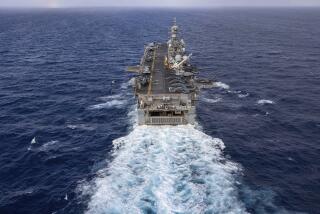U.S. Strategists Studying Futuristic Alternatives to Overseas Bases
- Share via
WASHINGTON — U.S. defense strategists are talking increasingly about futuristic alternatives to overseas bases that would make unnecessary the messy and unending job of negotiating new base accords with foreign governments.
Some of the strategists’ high-technology plans sound like ideas from a Buck Rogers movie. Planners are working on aerospace planes and new kinds of weapons systems that would be delivered by intercontinental ballistic missiles. As a substitute for bases on foreign soil, they are exploring the military possibilities of container ships, artificial islands, barges and prefabricated airstrips.
Imagine, for example, that the Philippine government forces the United States to leave Clark Air Base and Subic Bay Naval Base when the current agreement expires in 1992. If Pentagon visionaries translate some of their dreams into reality, the United States within two decades could have “standard merchant container ships,” stocked with U.S. military equipment, floating in the ocean near the Philippines for use if war broke out.
That idea may sound far-fetched, but it was suggested recently by the Commission on Integrated Long-Term Strategy, whose members included former National Security Advisers Henry A. Kissinger, Zbigniew Brzezinski and William P. Clark.
“Located in international waters, or in an ally’s territorial waters but still out of view, our operations can be far more secure than those on land bases,” the commission said.
It is the need to be “out of view” that has prompted the Defense Department to begin looking for some new, high-tech form of military base.
“We should not ordinarily be dependent on bases in defending our interests in the Third World,” the commission said in its recent report. “We have found it increasingly difficult, and politically costly, to maintain bases there.” Friendly governments, the report said, “become vulnerable to nationalist charges that they are surrendering sovereignty by allowing us to use ports, airfields and other territory.”
James Blaker, a former Defense Department official who prepared a study of U.S. bases for the Hudson Institute, a conservative think tank, says that the high-tech ideas now being explored include the use of hypersonic aerospace planes that could travel halfway around the world in a few hours. Extending the distance that warplanes can travel without refueling would lessen the need for overseas bases, he says.
In addition, Blaker said, defense strategists are examining the possibility of new non-nuclear weapons systems that could be delivered by intercontinental ballistic missiles.
“By combining ballistic missiles with homing interceptor warheads, for example, aircraft intercept ranges may extend to 1,200 miles or more,” the Hudson Institute said in its study.
Still, the Hudson report concluded that “the fruits of these technologies will probably not be available for at least a decade.” From now through the mid-1990s, it said, “there are few technological fixes to the base-site scarcity.”
Not all of the replacements for bases are high-tech. Blaker says that the most likely possibility over the next decade is that the Pentagon will turn to some simple, low-technology alternatives for military bases, such as huge barges or “artificial islands” that might carry military equipment and other support.
Some of this technology is already in use.
British forces used barges during the Falklands War against Argentina, and a State Department official says those barges were lent to Britain by the United States. Now, the United States is using the barges, or “sea bases,” to support its operations in the Persian Gulf.
The U.S. barges in the gulf, which are protected by anti-aircraft missiles, are reportedly large enough to carry patrol boats, attack helicopters and radar and communications facilities.
More to Read
Sign up for Essential California
The most important California stories and recommendations in your inbox every morning.
You may occasionally receive promotional content from the Los Angeles Times.













